
Choosing a Food Service Cart Guide
If you are running a restaurant, hotel, or school cafeteria, you know the importance of having the right utility cart for the job. Whether you are transporting full bus tubs back to the kitchen or delivering meals for room service, a transport cart with the right weight capacity, caster type, and handle design can make your job infinitely easier.
This guide is designed to help you narrow down the search for the best food service cart for your application by outlining factors like plastic carts versus metal carts, wheel types, ergonomic handle designs, and actual weight capacity.
Folding Carts
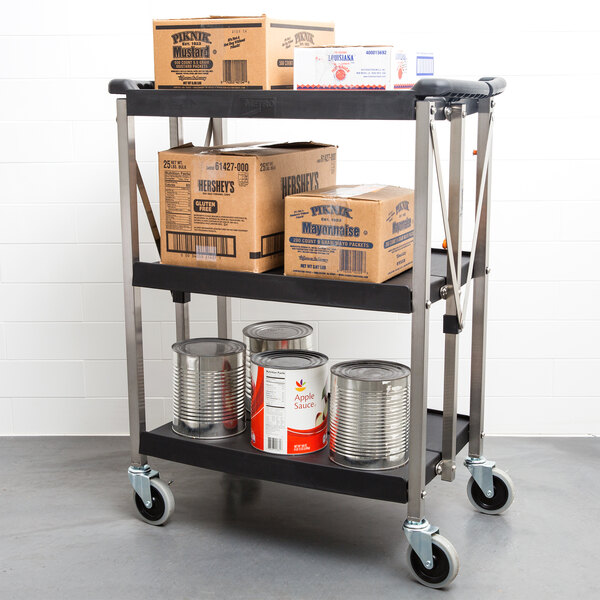
Regular utility and bussing carts take up a lot of valuable space to store-space that you could be using for storing consumables, disposable supplies, restaurant high chairs, or other essentials. Folding carts are perfect for transporting goods and also saving space. Below, we describe the benefits of choosing a folding utility cart.
- They make the perfect bus cart for catering events or small foodservice establishments.
- Folding carts free up storage space.
- Can be carried with ease from catering events to help you transport heavy chafers, insulated food carriers, and loaded food pans.
Metal Carts vs. Plastic Carts
Choosing plastic versus metal really comes down to the amount and type of use the cart will be getting, along with personal preference. Sometimes a metal cart is necessary, but in other instances a plastic cart will do the same job just as well or better. Below we outline the benefits of choosing metal and plastic utility carts.
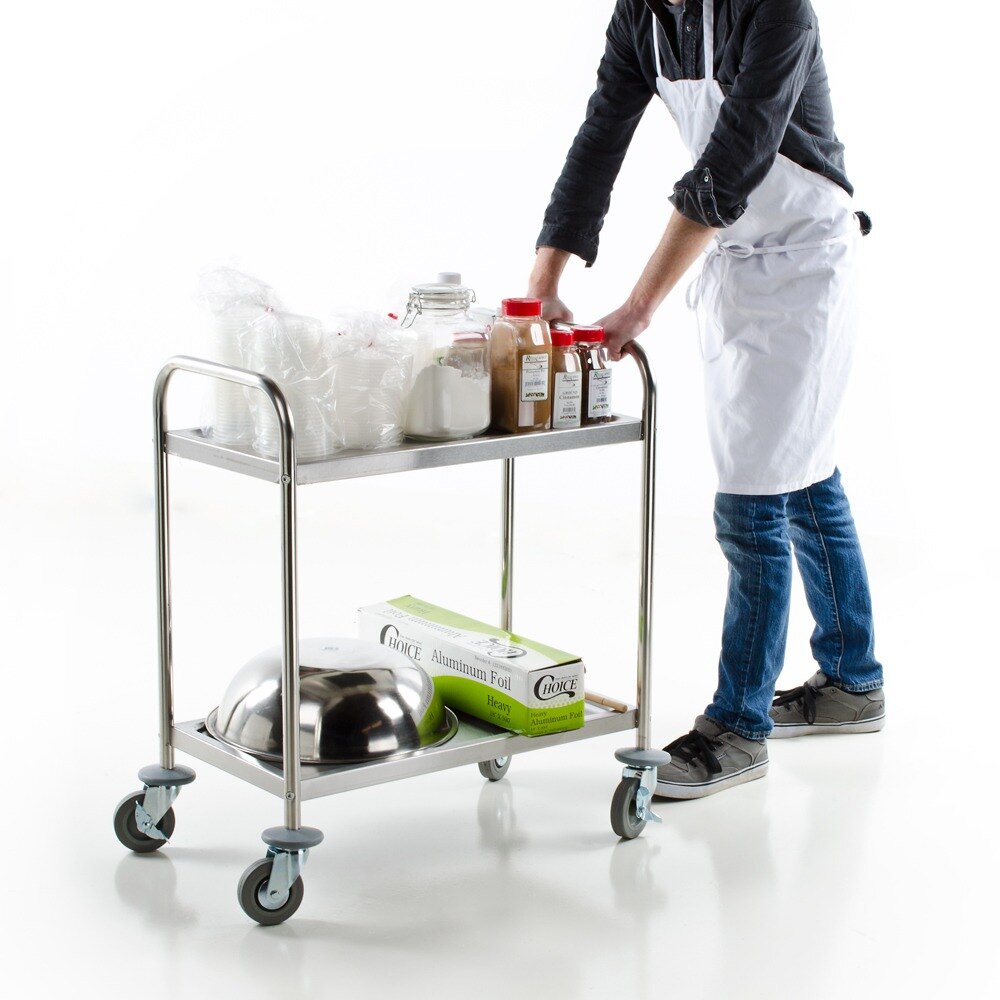
Metal Carts
Many metal utility carts provide long-lasting durability to aid you in transporting just about any load that you need to move; however, they can be more predisposed to show dents and scratches than plastic carts.
- Most are made from stainless steel for excellent rust resistance to keep your cart sanitary and safe for use.
- The gauge of the steel plays an important part in the cart's durability. The lower the gauge, the stronger and more durable the steel will be.
- They come in a variety of different styles so that you can find the perfect cart for your application, from light-duty to heavy-duty usage.
Plastic Carts
Plastic foodservice carts are a cost-effective alternative to metal carts. In the right establishment, plastic carts can be just as beneficial as metal.
- Plastic carts are lighter than metal carts.
- Many plastic utility carts are chip, dent, and stain resistant where metal would show scratches and dents.
- They provide an aesthetic appeal for bussing tables in the front of the house, but they can be used for transporting meals and catering supplies, too.
Utility Cart Durability
Durability takes into account several different elements to determine how the cart will hold up under certain uses over time. Some of the factors that play a part in how durable a cart will be and how much weight it can handle include:
- The gauge (or thickness) of the material used
- Type of fastening used
- Frame design
- Size, configuration, and makeup of the casters
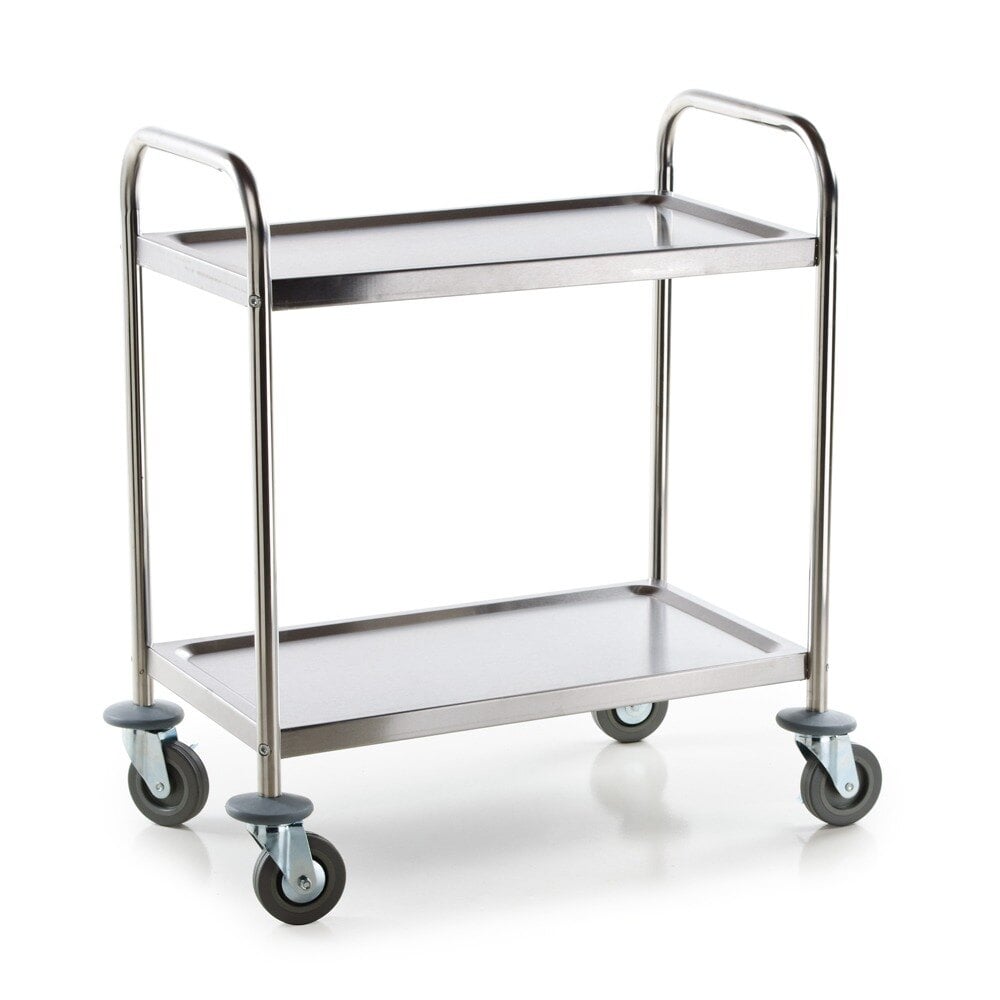
Light Duty Utility Carts
Maximum Total Weight Capacity: Less than 300 lbs.
Maximum Daily Hours of Use: 3 hours
Typical Uses: Janitorial, catering, bussing
Example: Choice 18 Gauge Stainless Steel 2 Shelf Utility Cart
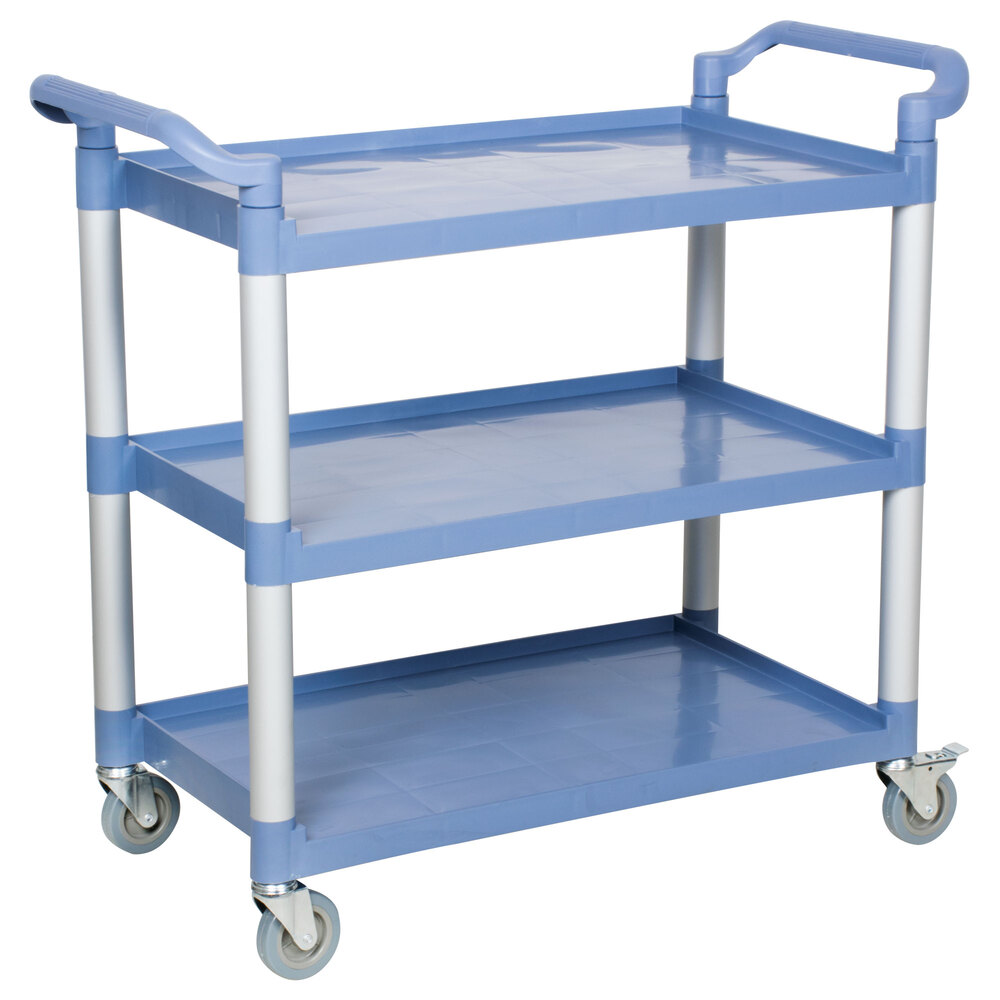
Standard / Medium Duty Utility Carts
Maximum Total Weight Capacity: 300 - 700 lbs.
Maximum Daily Hours of Use: 12 hours
Typical Uses: Table set up, recieving, bussing, China and glassware handling
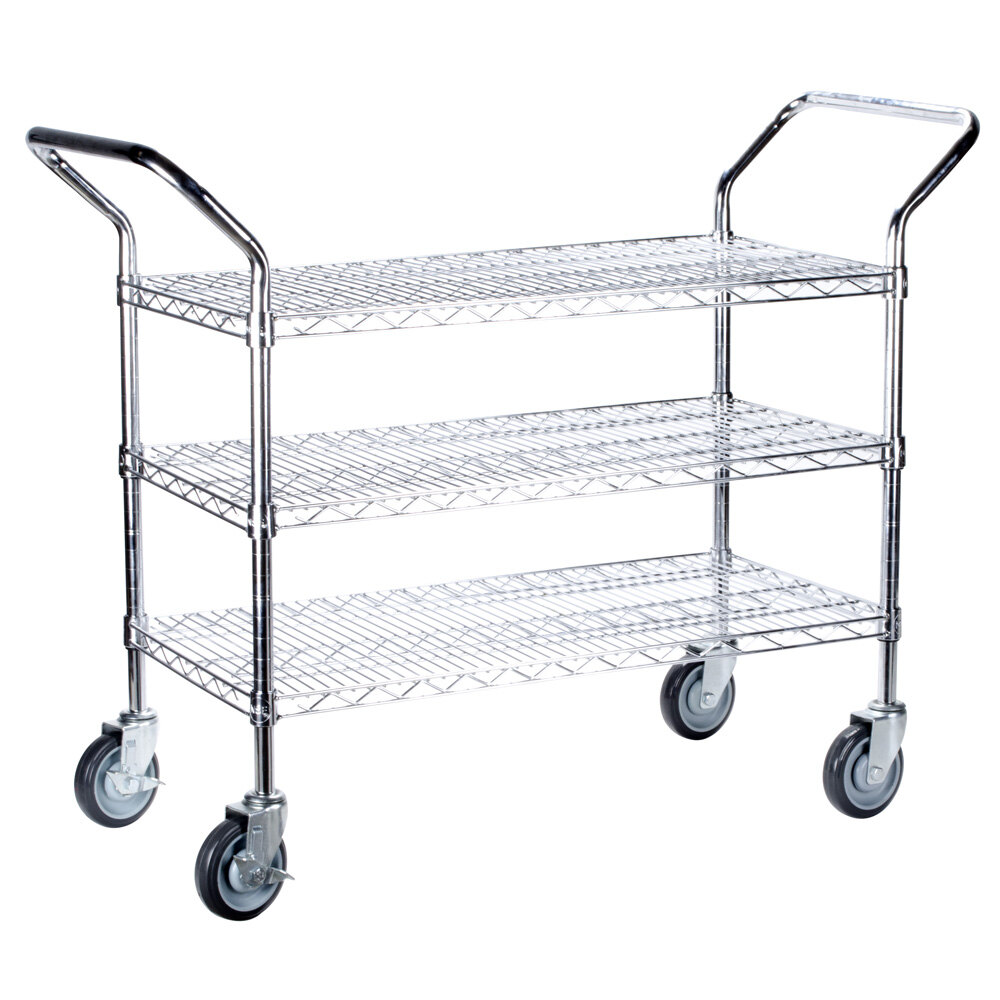
Heavy Duty Utility Carts
Maximum Total Weight Capacity: 700 - 1800 lbs.
Maximum Daily Hours of Use: 18 hours
Typical Uses: Storage room, recieving, China and flatware transport
Example: Regency 18" x 36" 3 Shelf Chrome Heavy Duty Utility Cart
Utility Cart HandlesUtility cart handles come in two different styles: molded-in and vertical. The type of handle you'll need for your foodservice business is based on preference and comfort. If using the cart for long periods of the day, most prefer vertical styled handles.
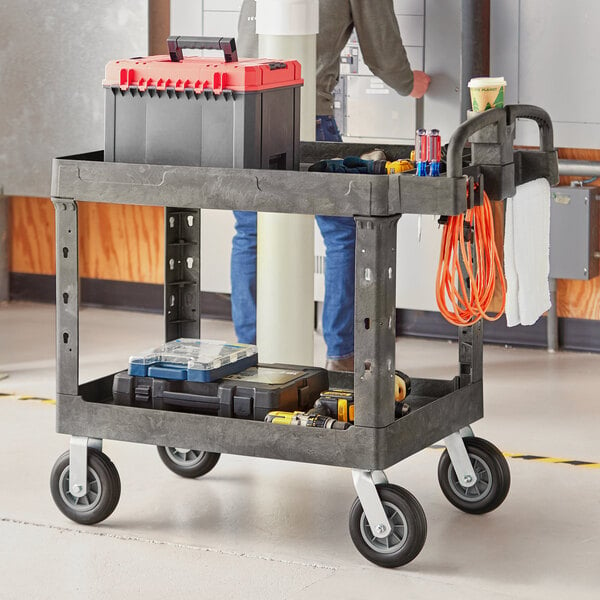
Molded-in Handles
For durability and continuity of design, molded-in handles are used in many types of carts, though primarily in plastic bussing and transport carts. Most molded-in handles are horizontal, but some may be designed with a vertical element as well.
Vertical Handles
This style of handles is usually found on metal bussing and utility carts with greater weight capacities. The vertical design has ergonomic value in that it allows people of different heights to push the same cart safely and with correct posture. If your employees will be using a cart for several hours a day, vertical handles can help prevent injuries caused by pushing heavy loads.

Vertical cart handles allow employees of different heights to operate the cart with correct, safe posture, reducing the risk of work-related injuries!
Food Service Cart Configurations
Food service carts come in many different styles such as enclosed, open, and shelf lip. Below we describe the benefits of each and how they operate.
Enclosed Carts
Some carts have enclosed or partially enclosed bases with shelves inside. The benefits of this configuration include spill prevention and hiding unsightly bus boxes or cleaning supplies from view. Most often, only plastic utility carts have enclosed bases, though some manufacturers make cabinet-style metal bussing carts.
Open Carts
Many metal and plastic bussing carts have open bases. This makes loading and unloading the cart easier and allows for easy viewing of the contents for inventory or inspection reasons.
Shelf Lip Carts
Many carts have a lip on all four sides of the shelf or on three sides to prevent items from sliding off. A shelf with a lip on all four sides may also contain spills if you are transporting liquids like soups, beverages, or cleaning supplies.
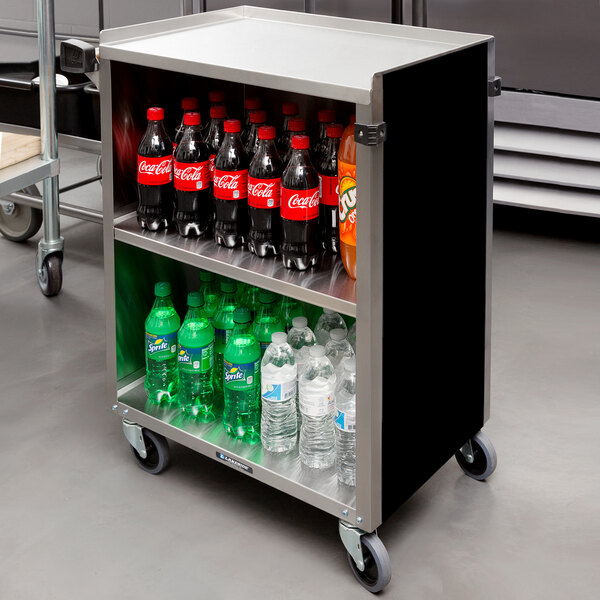
Weight Capacities
Though a cart has a general, overall weight capacity, it is important to note that weight should be evenly distributed among the shelves. A single shelf should only hold a portion of the overall weight capacity.
To find that number and help prevent injuries or damage to the cart, divide the overall weight capacity of the cart by the number of shelves. We've provided an easy-to-use weight capacity calculator at the bottom of this guide to give you an idea of the weight capacity that would work best for a cart in your application.
Number of Shelves
We offer utility carts with 2 shelves, 3 shelves, and 4 shelves to give you the best selection. More shelves may give a cart added weight capacity, but they also limit the clearance between shelves, while carts with only two shelves will have the greatest shelf clearance.
When deciding how many shelves you need, consider the actual size of the items you need to transport, not just the weight, to make sure they will fit the shelf clearance.

If your employees will be loading and unloading the cart frequently, choosing a cart with higher bottom shelves, or no lower shelves at all, can help reduce the risk of work-related injuries!
Rolling Utility Carts
Rolling utility carts are a must have for the foodservice industry. Rolling carts offer carts on a set of casters to easily navigate through your facility and transport products from one room to the next. Utility cart casters come in a variety of different styles and options such as fixed, swivel, non-marking, and more. Below, we break down what each style means so you can find the perfect rolling cart for your business.

- Brakes: If you won't be using your cart in a place where brakes are necessary, then this isn't something you will need to consider. If, however, you are planning to use a cart in areas where floors are not flat, where securing the cart is necessary, consider a cart with one or more locking casters.
- Swivel vs. Fixed: Depending on your application, one or the other (or a combination of both) might be best. If you will use the cart for bussing tables in the dining room and need maximum maneuverability, swivel casters may be best. If you will use it for transporting products up and down straight aisles, two or four fixed casters will help keep the cart steady.
- Non-Marking: Also called non-marring, or no-mark, non-marking cart casters won't leave tracks on your hard floors. If your establishment is mainly carpet or industrial space, you may not need to worry about non-marking casters, but if you have hard tile, wood, or linoleum floors, non-marking casters will help prevent damage.
- Bumpers: Though they look like small rubber donuts, bumpers are mounted on the uprights just above the casters and help protect walls, doors, and furniture. If you use swing doors in your kitchen or walk-in refrigeration, or use your cart in public areas where scuffs would be unsightly, bumpers help to prevent surfaces from coming into contact with the casters or corners of the cart.

Does your establishment have a lot of thresholds, elevators, or uneven floors? If so, consider a cart with larger wheels! It will be able to navigate this rough terrain much more easily than a cart with small casters, reducing the stress on the operator.
How to Assemble a Utility Cart
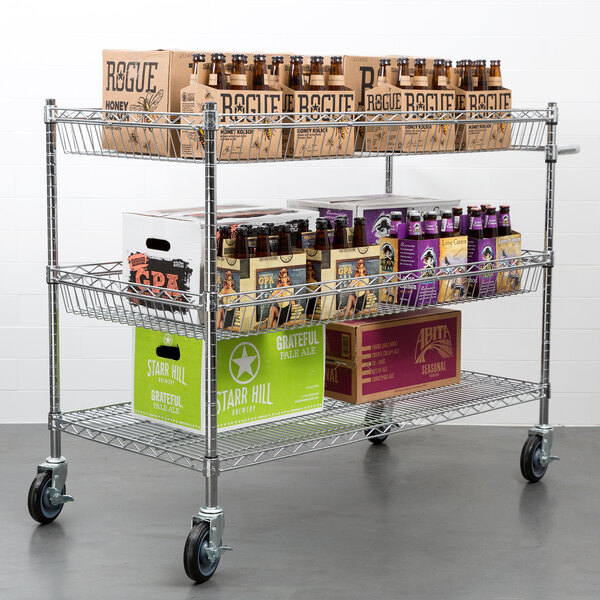
The two words "assembly required" may bring up traumatic memories for some, but our utility carts that come knocked down are actually quite easy to put together. When you consider the whether you are going to buy your utility cart assembled or unassembled, here is what you need to know.
- Shipping unassembled saves money in the long run by reducing the cost of shipping, so if your business is on a tight budget, that may be the way for you to go.
- Shipping assembled saves effort and provides maximum convenience.
- Choosing an assembled cart may be worth it if you want to start using your cart right out of the box.
We offer a number of Regency assembled and unassembled utility carts that are cost-effective. Watch the video below for instructions on how to assemble our Regency carts.
<h3>How to Assemble a Regency Utility Cart</h3>
![]()
0:00
Total Load Capacity Calculator for Food Service Carts
Calculator Instructions
What is this calculator?
This calculator takes into account typical environmental factors to determine the total load capacity that would work best for a cart in your application.
How do I use this calculator?
Simply enter the estimated weight of typical items you will transport. Start with 100, even if the items you will transport are less than 100 lb., to account for the base weight. Check the boxes that apply to your situation, click "Calculate", and view the total in the "Total Load Capacity" field. To clear the fields and calculate again, click the "Reset" button.
What is "Total Load Capacity"?
Total load capacity is the total weight that your cart can hold and transport. This assumes that the weight is distributed evenly over all of the shelves. To find the total load capacity, simply add together the weights of all the items on all the shelves. To find the capacity of a single shelf, divide the cart's total load capacity by the number of shelves. The total load capacity below is shown in pounds.
What are approximate weights of some common food service items?
- 2 cases of #10 cans of sauce = 84 lb.
- 2 bus tubs filled with 8 place settings = 70 lb.
- 1 full size pan filled with mashed potatoes = 32 lb.
- 1 18" x 26" x 8" box filled with 48 flatware set-ups = 48 lb.
Utility carts are perfect for transporting goods in restaurants, hotels, and at catering events. It is important to understand the different styles that utility carts come in so you can choose the right foodservice cart for your business.
Utility cart handles come in two different styles: molded-in and vertical. The type of handle you'll need for your foodservice business is based on preference and comfort. If using the cart for long periods of the day, most prefer vertical styled handles.

Molded-in Handles
For durability and continuity of design, molded-in handles are used in many types of carts, though primarily in plastic bussing and transport carts. Most molded-in handles are horizontal, but some may be designed with a vertical element as well.
Vertical Handles
This style of handles is usually found on metal bussing and utility carts with greater weight capacities. The vertical design has ergonomic value in that it allows people of different heights to push the same cart safely and with correct posture. If your employees will be using a cart for several hours a day, vertical handles can help prevent injuries caused by pushing heavy loads.

Vertical cart handles allow employees of different heights to operate the cart with correct, safe posture, reducing the risk of work-related injuries!
Food Service Cart Configurations
Food service carts come in many different styles such as enclosed, open, and shelf lip. Below we describe the benefits of each and how they operate.
Enclosed Carts
Some carts have enclosed or partially enclosed bases with shelves inside. The benefits of this configuration include spill prevention and hiding unsightly bus boxes or cleaning supplies from view. Most often, only plastic utility carts have enclosed bases, though some manufacturers make cabinet-style metal bussing carts.
Open Carts
Many metal and plastic bussing carts have open bases. This makes loading and unloading the cart easier and allows for easy viewing of the contents for inventory or inspection reasons.
Shelf Lip Carts
Many carts have a lip on all four sides of the shelf or on three sides to prevent items from sliding off. A shelf with a lip on all four sides may also contain spills if you are transporting liquids like soups, beverages, or cleaning supplies.

Weight Capacities
Though a cart has a general, overall weight capacity, it is important to note that weight should be evenly distributed among the shelves. A single shelf should only hold a portion of the overall weight capacity.
To find that number and help prevent injuries or damage to the cart, divide the overall weight capacity of the cart by the number of shelves. We've provided an easy-to-use weight capacity calculator at the bottom of this guide to give you an idea of the weight capacity that would work best for a cart in your application.
Number of Shelves
We offer utility carts with 2 shelves, 3 shelves, and 4 shelves to give you the best selection. More shelves may give a cart added weight capacity, but they also limit the clearance between shelves, while carts with only two shelves will have the greatest shelf clearance.
When deciding how many shelves you need, consider the actual size of the items you need to transport, not just the weight, to make sure they will fit the shelf clearance.

If your employees will be loading and unloading the cart frequently, choosing a cart with higher bottom shelves, or no lower shelves at all, can help reduce the risk of work-related injuries!
Rolling Utility Carts
Rolling utility carts are a must have for the foodservice industry. Rolling carts offer carts on a set of casters to easily navigate through your facility and transport products from one room to the next. Utility cart casters come in a variety of different styles and options such as fixed, swivel, non-marking, and more. Below, we break down what each style means so you can find the perfect rolling cart for your business.

- Brakes: If you won't be using your cart in a place where brakes are necessary, then this isn't something you will need to consider. If, however, you are planning to use a cart in areas where floors are not flat, where securing the cart is necessary, consider a cart with one or more locking casters.
- Swivel vs. Fixed: Depending on your application, one or the other (or a combination of both) might be best. If you will use the cart for bussing tables in the dining room and need maximum maneuverability, swivel casters may be best. If you will use it for transporting products up and down straight aisles, two or four fixed casters will help keep the cart steady.
- Non-Marking: Also called non-marring, or no-mark, non-marking cart casters won't leave tracks on your hard floors. If your establishment is mainly carpet or industrial space, you may not need to worry about non-marking casters, but if you have hard tile, wood, or linoleum floors, non-marking casters will help prevent damage.
- Bumpers: Though they look like small rubber donuts, bumpers are mounted on the uprights just above the casters and help protect walls, doors, and furniture. If you use swing doors in your kitchen or walk-in refrigeration, or use your cart in public areas where scuffs would be unsightly, bumpers help to prevent surfaces from coming into contact with the casters or corners of the cart.

Does your establishment have a lot of thresholds, elevators, or uneven floors? If so, consider a cart with larger wheels! It will be able to navigate this rough terrain much more easily than a cart with small casters, reducing the stress on the operator.
How to Assemble a Utility Cart

The two words "assembly required" may bring up traumatic memories for some, but our utility carts that come knocked down are actually quite easy to put together. When you consider the whether you are going to buy your utility cart assembled or unassembled, here is what you need to know.
- Shipping unassembled saves money in the long run by reducing the cost of shipping, so if your business is on a tight budget, that may be the way for you to go.
- Shipping assembled saves effort and provides maximum convenience.
- Choosing an assembled cart may be worth it if you want to start using your cart right out of the box.
We offer a number of Regency assembled and unassembled utility carts that are cost-effective. Watch the video below for instructions on how to assemble our Regency carts.
<h3>How to Assemble a Regency Utility Cart</h3>
0:00
Total Load Capacity Calculator for Food Service Carts
Calculator Instructions
What is this calculator?
This calculator takes into account typical environmental factors to determine the total load capacity that would work best for a cart in your application.
How do I use this calculator?
Simply enter the estimated weight of typical items you will transport. Start with 100, even if the items you will transport are less than 100 lb., to account for the base weight. Check the boxes that apply to your situation, click "Calculate", and view the total in the "Total Load Capacity" field. To clear the fields and calculate again, click the "Reset" button.
What is "Total Load Capacity"?
Total load capacity is the total weight that your cart can hold and transport. This assumes that the weight is distributed evenly over all of the shelves. To find the total load capacity, simply add together the weights of all the items on all the shelves. To find the capacity of a single shelf, divide the cart's total load capacity by the number of shelves. The total load capacity below is shown in pounds.
What are approximate weights of some common food service items?
- 2 cases of #10 cans of sauce = 84 lb.
- 2 bus tubs filled with 8 place settings = 70 lb.
- 1 full size pan filled with mashed potatoes = 32 lb.
- 1 18" x 26" x 8" box filled with 48 flatware set-ups = 48 lb.
Utility carts are perfect for transporting goods in restaurants, hotels, and at catering events. It is important to understand the different styles that utility carts come in so you can choose the right foodservice cart for your business.
Related Resources

Foodservice Towels for Sanitation
Foodservice towels and wipes are essential to several foodservice tasks, such as cleaning up spills, sanitizing food-contact surfaces, and dusting display counters. Using disposable and reusable foodservice towels can help your establishment abide by food safety guidelines . This guide outlines the types of foodservice wipes available to you so you can maintain the highest standard of cleanliness on all surfaces.
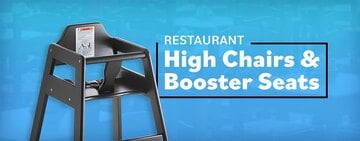
Types of Restaurant High Chairs and Booster Seats
Restaurant high chairs and booster seats are the perfect way to keep your youngest customers safe and comfortable. In order to cater to a variety of ages, it's important to include both high chairs and booster seats when determining your restaurant seating options and dining room layout . While each option comes with its own features and benefits, high chairs are more suitable for infants and booster seats are great for toddlers.

Types of Aprons
Restaurant aprons are a vital part of most restaurant employee dress codes . Aprons protect clothing from spills and stains and make foodservice staff look professional. They also help uphold food safety standards. We explain the benefits and uses of the different types of aprons so you can select the apron style that befits your restaurant business model. Shop All Aprons Skip to the apron information that interests you: Apron Styles Apron Fabrics How to Tie an Apron How to Wash Aprons Apron Benefits History of Aprons
- Topics 1343
- Industrial 55
- Troubleshooting Guides 21
- Restaurant Management 128
- Bar Management 55
- Catering Tips 35
- Bakery Management 41
- Food Trucks & Concessions 49
- Advertising & Marketing 37
- Eco-Friendly Tips 11
- Facility Layout & Design 41
- Coffee Shop Tips 27
- Installation & Maintenance 51
- Janitorial & Pest Control 30
- Safety & Sanitation 88
- Startup Tips 104
- Menu Design 10
- Kitchen & Cooking Tips 81
- Hospitality Management 23
- Pizza & Sandwich Shop Tips 35
- Smallwares 37
- Food Prep 88
- Tabletop Items 17
- Disposables 22
- Calculators & Tools 6
- Consumables 52
- Warewashing & Laundry 18
- Cooking Equipment 90
- Food Storage & Refrigeration 51
- Beverage Equipment 34
- Office Supplies 6
- Resource Type
- In-Depth Articles271
- Buying Guides296
- How-Tos93
- Product Reviews77


